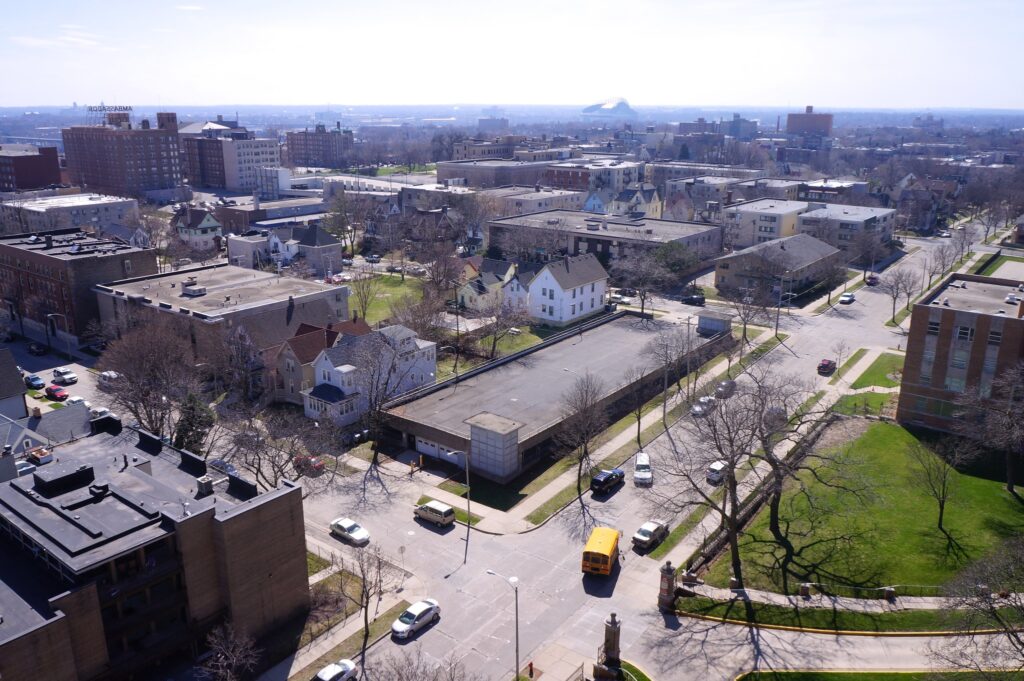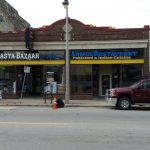City, State Have Rare Chance to Address Climate Change
Billions in federal aid flowing to Wisconsin. Citizen input could guide how funds spent.

Congress passed the Bipartisan Infrastructure and Investment and Jobs Act in 2021. Will these funds reach Milwaukee neighborhoods? File photo by Adam Carr/NNS.
Milwaukee has a once-in-a-generation window to think big and work with residents to increase the creativity, opportunity and joy in our central city neighborhoods.
What would you like to see in your neighborhood?
- More locally owned businesses — restaurants, entertainment options, stores?
- Well-paying and dignified work opportunities?
- State-of-the-art housing?
- Beautifully designed parks with fun places for kids to play?
- Convenient public transportation?
Something else?
A $550 billion investment
In 2021, Congress passed the Bipartisan Infrastructure Investment and Jobs Act and has since begun investing $550 billion to improve the physical condition of communities.
This investment promises to do many things at once.
It will address the “climate crisis”— the changing weather patterns that put neighborhoods at increased risk of natural disaster — by investing in environmentally friendly projects.
Funding will support the rebuilding of America’s roads, bridges and rails; expanded access to clean drinking water; high-speed broadband access; electric vehicle chargers; and more.
This infrastructure investment is on top of the Inflation Reduction Act of 2022, which provides billions of additional dollars for tax credits, rebates and grants to promote consumer adoption and business manufacturing of cleaner energy technologies.
The Inflation Reduction Act includes a national total of $3 billion for Environmental and Climate Justice Block Grants for community-led projects and another $3 billion in Neighborhood Access and Equity Grants for affordable transportation access in disadvantaged communities.
Will our neighborhoods benefit?
New green jobs will be created through these laws that pay living wages and offer new career pathways. The Biden administration has promised that these investments will focus on equity by making sure communities that “too often been left behind” benefit.
In fact, the Biden administration started the Justice40 Initiative to ensure that at least 40% of these funds directly help residents of disadvantaged neighborhoods.
So, how will this funding be spent to help you and your neighborhood?
As of February, $2.8 billion of the Infrastructure Act funding has been allocated to Wisconsin and has supported 170 projects with more than 85% going to roads, bridges, public transit, ports and airports.
Remaining funds have supported projects such as clean water access through the replacement of lead pipe laterals and resident discounts for internet service through the Affordable Connectivity Program.
Total federal infrastructure funding to Wisconsin will exceed $5 billion over five years to fund project areas such as “brownfield” pollution cleanup, weatherization initiatives, public transit efficiency (e.g. clean buses) and electric vehicle charging stations.
Governor proposes new projects, too
Gov. Tony Evers recently proposed that, over the next two years, state funding should support new projects such as a Southeast Wisconsin Green Jobs Corps, a clean energy and small business incubator, and other projects that will create 40,000 new jobs by 2030.
These state-level investments have only been proposedas part of the 2023-’25 budget and must be approved through the budget process that includes assent by the Republican-led legislature.
Many questions remain:
- Will these projects and investments take advantage of a once in a generation opportunity to transform neighborhoods “too often left behind?”
- What is a green job? What training is needed and how much will these jobs pay? How many and in what communities will these jobs be available?
- Can infrastructure projects focused on the environment also address public safety, affordable housing and other areas of pressing community need?
- How much funding will make its way to Milwaukee’s neighborhoods? What other resources — financial, human and otherwise — are needed to achieve these goals?
Of course, similar projects and investments have been made in the past and have not resulted in transformation. It is clear that “business as usual” approaches — simply increasing funding of existing programs — are unlikely to achieve greater climate equity.
A time for innovation
Examples exist, however, of innovative projects and new ways to directly engage residents that are transforming lives, neighborhoods and economic realities.
The window of opportunity has already begun to close, however.
You can make a difference.
You will have the opportunity to participate in upcoming public hearings and share how you think state funding should be spent.
The Wisconsin Office of Sustainability and Clean Energy is working to develop reporting tools and gather resident input to ensure that communities like yours benefit from federal funds.
Your voice and ideas can help to ensure that this once in a generation investment makes a big difference in your community.
I hope you will join me in investigating existing projects and new ideas that will help us increase the creativity, opportunity and joy in Milwaukee’s central city neighborhoods.
David Libert is a Milwaukee resident, educator, nonprofit consultant and talent recruiter. You can contact him at dplibert76@gmail.com or 414-331-4113 to share stories and ideas about the people, programs and projects you like or want to see in your neighborhood.
OPINION: Milwaukee has the rare chance to address the climate crisis. Let’s not blow it. was originally published by the Milwaukee Neighborhood News Service.
Op-Ed
-
Wisconsin Candidates Decry Money in Politics, Plan to Raise Tons of It
 Dec 15th, 2025 by Ruth Conniff
Dec 15th, 2025 by Ruth Conniff
-
Trump Left Contraceptives to Rot; Women Pay the Price
 Dec 8th, 2025 by Dr. Shefaali Sharma
Dec 8th, 2025 by Dr. Shefaali Sharma
-
Why the Common Council’s Amended Budget is Good Policy for Milwaukee
 Nov 20th, 2025 by Alds. Marina Dimitrijevic and Russell W. Stamper, II
Nov 20th, 2025 by Alds. Marina Dimitrijevic and Russell W. Stamper, II






















Something good may come of this, but the Governor’s plan to increase employment by 40,000 here in seven years while at the same time reducing (a) energy consumption; (b) solid waste; and (c) water consumption makes no sense. None of those things will happen with another 40,000 using those services. The Mayor wants to increase the population of Milwaukee by 400,000. It is impossible to increase the population that much and reduce consumption.
I will be curious to see how a “disadvantaged neighborhood” is defined. Compared to the spending on downtown they are all disadvantaged. The Central City? Yes. But what of every other part of the city neglected by the fascination with spending tax money downtown? We all pay taxes and watch our streets become like minefields. We are always told the city cannot afford to fix them. Well, this is the time.
Long-term decisions about energy sources, land use, zoning, and transportation have contributed to climate change. As a result, we now have a rural-to-urban landscape that requires much travel and encourages low-density land use for housing and transportation. The laws and decisions that have led to this need to change.
Stop the increase in suburban sprawl and low-density development that destroys watersheds and wildlife habitats and harms the environment.
Stop the destruction of agricultural land and natural wildlife areas.
Stop highway widening that increases automobile dependence and pollution, destroys natural habitats, destroys housing and businesses for people, and leads to still more highway construction.
Stop the regulation of towns and cities that prevents the placement of jobs, housing, shops, recreation, and other life-supporting resources in proximity. Instead, allow the freedom for land use that is more compact. This closeness allows people to meet much of their daily needs through active forms of transit–walking and bicycling. In addition, allow alternative forms of transportation, including public transportation, to support areas of sufficient density.
Allow people the freedom of choice for more diverse affordable housing to allow better use of land already served with infrastructure. Eliminate single-family zoning and minimum parking requirements. Eliminate the power of NIMBY opposition to stop the construction of affordable homes, including multi-family duplexes, fourplexes, and taller buildings in towns and very tall buildings in cities. Eliminate parking requirements. Allow for infill development. Allow cities and towns to support public transportation that can serve this denser landscape well and eliminate the need for car trips.
The cost of providing services such as water, sewer, utilities, streets, and maintenance is higher for low-density development. Therefore, those areas need a sufficient local tax basis to maintain local infrastructure.
Support areas of towns and cities that are more productive in terms of return on public and private investments. Sprawl areas of big box stores and single-family housing have a lower return per unit area than dense and diverse areas of cities. The parking lots, swaths of unused paved areas, and unnecessarily low-density housing increase energy use, require more travel time, complicate water management, and are more expensive to maintain.
Allow towns, cities, and metropolitan areas the freedom to sustainably address their needs for housing, workplaces, businesses, and public services such as parks, libraries, and transportation. Heavy-handed state and local regulations against public transportation, multi-family housing, and people-oriented (as opposed to car-oriented) land use must be eliminated.
Patterns of human settlement for centuries have shown multiple strategies for people to live in towns, cities, and metropolitan areas in a sustainable, dignified, healthy way, with thriving small and medium-sized businesses and a stable tax and public funding plan. Allow the freedom for the great diversity of large cities to thrive as well as smaller cities, towns, and rural areas–each with its character and each allowed to focus on using the land more wisely.
Apply to the deficit